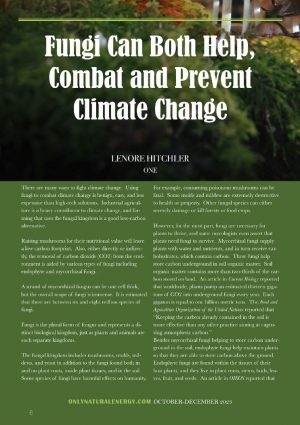 There are many ways to fight climate change. Using fungi to combat climate change is benign, easy, and less expensive than high-tech solutions. Industrial agriculture is a heavy contributor to climate change, and farming that uses the fungal kingdom is a good low-carbon alternative. Raising mushrooms for their nutritional value will leave a low carbon footprint. Also, either directly or indirectly, the removal of carbon dioxide (CO2) from the environment is aided by various types of fungi including endophyte and mycorrhizal fungi.
There are many ways to fight climate change. Using fungi to combat climate change is benign, easy, and less expensive than high-tech solutions. Industrial agriculture is a heavy contributor to climate change, and farming that uses the fungal kingdom is a good low-carbon alternative. Raising mushrooms for their nutritional value will leave a low carbon footprint. Also, either directly or indirectly, the removal of carbon dioxide (CO2) from the environment is aided by various types of fungi including endophyte and mycorrhizal fungi.
A strand of mycorrhizal fungus can be one cell thick, but the overall scope of fungi is immense. It is estimated that there are between six and eight million species of fungi. Fungi is the plural form of fungus and represents a distinct biological kingdom, just as plants and animals are each separate kingdoms. The fungal kingdom includes mushrooms, molds, mildews, and yeast in addition to the fungi found both in and on plant roots, inside plant tissues, and in the soil.
Some species of fungi have harmful effects on humanity. For example, consuming poisonous mushrooms can be fatal. Some molds and mildew are extremely destructive to health or property. Other fungal species can either severely damage or kill forests or food crops.
However, for the most part, fungi are necessary for plants to thrive, and some mycologists even assert that plants need fungi to survive. Mycorrhizal fungi supply plants with water and nutrients, and in turn receive carbohydrates, which contain carbon. These fungi help store carbon underground in soil organic matter. Soil organic matter contains more than two-thirds of the carbon stored on land. An article in Current Biology reported that worldwide, plants pump an estimated thirteen gigatons of CO2 into underground fungi every year. Each gigaton is equal to one billion metric tons. The Food and Agriculture Organization of the United Nations reported that “Keeping the carbon already contained in the soil is more effective than any other practice aiming at capturing atmospheric carbon.”
Besides mycorrhizal fungi helping to store carbon underground in the soil, endophyte fungi help maintain plants so that they are able to store carbon above the ground. Endophyte fungi are found within the tissues of their host plants, and they live in plant roots, stems, buds, leaves, fruit, and seeds. An article in OIKOS reported that “Growing evidence indicates that endophytes are found in all plants.” An article in the American Journal of Biology added that fungal endophytes are symbionts “that can affect plant physiology and growth under stressed conditions. … In very stressful thermal or saline environments, endophytes have been isolated that confer heat or salt resistance on a variety of plant hosts.” According to an article in The ISME Journal, “native grass species from coastal and geothermal habitats require symbiotic fungal endophytes for salt and heat tolerance.”
Endophytes also help to protect plants from other forms of stress such as heavy metals, including arsenic, cadmium, lead, and chromium. According to an article in Frontiers in Microbiology, endophytic fungi increased their host plant’s tolerance to heavy metals, thus helping their host’s ability to survive in contaminated soil.
Besides helping plants cope with toxic metals, endophytic fungi are important in combating plant stress due to climate change as reported in The ISME Journal. The article reported that “The ability of fungal endophytes to confer stress tolerance to plants may provide a novel strategy for mitigating the impacts of global climate change on agricultural and native plant communities.”
One climate change-induced stress for agricultural crops is increased pest infestations. According to an article in The Quarterly Review of Biology, endophytes provide “pathogen immunity to their host; they can also ward off herbivores.” An article in Frontiers in Microbiology reported that “Chemicals produced by endophytic fungi were toxic or distasteful to insects.” Unfortunately, modern agriculture threatens valuable fungi. According to Alan Gange, Ph.D., professor of microbial ecology, plant breeding and fungicides have resulted in modern crops having far fewer natural fungal partners than their counterparts in the wild.
Agricultural crops are not the only types of plants that are reliant on fungi as trees also depend on fungi. Mycologist Paul Stamets reported that “Without fungi, there are no forests.” This is important as forests are extremely valuable in combating climate change. An article in Global Change Biology stated that “Forests represent 31% of global land surface area and currently offset around 2.4 Pg [each petagram equals 1 billion tonnes] of CO2 emissions every year by storing carbon in live plant biomass and soil.” An article in Plant Ecology added that “Many forests around the world would not exist in the absence of their mycorrhizal symbionts. Temperate, boreal, and Mediterranean forests harbor hundreds of different species of ectomycorrhizal fungi.” Thus, to combat climate change, trees need to thrive, and therefore the fungi originally found in forests must flourish.
Clear-cutting forests endangers fungi. In an article in The Guardian, Toby Kiers, Ph.D., professor of evolutionary biology, and microbiologist Merlin Sheldrake, Ph.D., discussed the harmful effect of logging on fungi. The article reported that “Logging wreaks havoc below ground, decreasing the abundance of mycorrhizal fungi by as much as 95%, and the diversity of fungal communities by as much as 75%.”
Tree roots are extremely important in storing carbon. An article in Scientific American reported that 50 to 70% of the carbon found in the soil comes from tree roots and the fungi that grow on them. Unfortunately, anything that harms fungi also limits the ability of forests to combat climate change. For example, pollution damages fungi. An article in Nature reported that “Pollution could be starving Europe’s trees of vital nutrients by damaging essential fungi. Signs of tree malnutrition, such as discolored or missing leaves, have been observed throughout European forests.” Dr. Laura Suz, of the Royal Botanic Gardens, a co-researcher on the study, stated that trees need mycorrhizae fungi to obtain nutrients and water from the soil.
Douglas fir trees are just one example of a tree species that are reliant on fungi. An article in Whole Earth Magazine reported that throughout the lifespan of a Douglas Fir tree, nearly 200 species of mycorrhizal mushrooms may form a symbiotic relationship with the tree. Ecologist Simone Webber, Ph.D., added that “Plants used the mycorrhizal network to ‘share’ warnings about predation, with species such as Douglas Fir sending stress signals into the mycorrhizal network when they are attacked by predators. These signals reach neighboring trees, which can then mount a defense, and even trees of different species exhibit this response.”
In addition to fungi helping trees and other plants store carbon in foliage and soil, growing mushrooms for dietary purposes will also help combat climate change. Less fossil fuels are used in their production than livestock or even growing agricultural crops. Mushrooms are produced with less water, land, and fossil fuels than otherwise would be used in the production, transportation, and application of fertilizers and pesticides. Thus, mushrooms are a low-carbon source of nutrition.
There are various nutrients in mushrooms that contribute to a healthy diet. An article in Nutrition Journal reported that “Our meta-analysis of prospective cohort studies found that mushroom consumption was associated with a lower risk of all-cause mortality. … A recent systematic review and meta-analysis of observational studies conducted by our research team indicated that higher mushroom consumption was associated with a lower risk of total cancer.” Robert Beelman, Ph.D., professor of food science, stated that mushrooms are good sources of antioxidants. “Oxidative stress is considered the main culprit in causing the diseases of aging such as cancer, heart disease and dementia. … A recent epidemiological study conducted with over 13,000 elderly people in Japan showed that those who ate more mushrooms had less incidence of dementia.” Thus, mushrooms may prevent various diseases, and recent research has even found that mushrooms may even help to cure various diseases, such as cancer.
Therefore, consuming mushrooms is part of a healthy and nutritious diet. Dr. Beelman added that mushrooms do not contain cholesterol or gluten and are low in fat, sugars, sodium, and calories, and are also a good source of vitamin D. An article in Nutrition Journal reported that mushrooms are good sources of phytochemicals, polysaccharides, and minerals, such as selenium and copper, in addition to essential vitamins, including such B-vitamins as niacin, thiamin, riboflavin, and vitamin C.
As well as providing many essential nutrients, mushrooms have the potential to become a major source of protein. According to an article in Frontiers in Sustainable Food Systems, “Fungal-derived mycoproteins are gaining in popularity due to their healthy nutritional profile, ability to be produced at low cost, environmental benefits, and resilience to landscape limitations such as flood or drought.”
An example of a high-protein mushroom is the Lactarius indigo (L. indigo) mushroom, also called the blue milk cap. It is native to the New World from Canada to southern Brazil, plus China and parts of India. It forms symbiotic relationships with trees. Therefore, to obtain protein from these mushrooms, forests would have to be retained, thus preventing deforestation, maintaining biodiversity, and storing carbon. According to an article in Science of the Total Environment, L. indigo can provide around fifteen pounds of protein per 2.47 acres whereas, in extensive pastoral systems, beef provides from around 10.49 pounds to 15.1 pounds of protein per 2.47 acres. Besides preventing deforestation, no fertilizers, pesticides, irrigation, or veterinary services are necessary. Animals will not have to suffer in factory farms and produce wastes that are too concentrated for soil decomposers to easily break down. Additionally, L. indigo has various characteristics that promote good health. For example, extracts showed strong antibacterial properties and “displayed significant inhibition of carcinogenic cells.”
Just as L. indigo can be used as a protein source, various other mushrooms can be processed to create an excellent protein. According to the Potsdam Institute for Climate Impact Research, “Microbial protein is made in specific cultures, just like beer or bread. The microbes are living on sugar and a steady temperature, and getting out a very protein-rich product that can taste like, feel like, and be as nutritious as red meat. Based on the centuries-old method of fermentation, it was developed in the 1980s. The U.S. Food and Drug Administration green-lighted a microbial protein meat alternative (mycoprotein) as safe in 2002.”
Besides being an excellent source of protein, mycoprotein provides important nutrients. The article in Frontiers in Sustainable Food Systems reported that “Microprotein, according to European Commission standards is ‘high in fiber,’ i.e., providing at least 0.21 ounces of fiber per 3.53 ounces. … When compared with the other protein food sources, mycoprotein does well for vitamin B9 (folate), vitamin B12, calcium, phosphorous, magnesium, and zinc.”
In addition to providing essential nutrients, mycoprotein from mushrooms is much more climate-friendly than protein from beef. This is extremely important because raising beef uses both a lot of energy and land. An article from Forbes reported that “More than a quarter of the planet’s ice-free land is used for cattle grazing, and a further 33% of all croplands are used to produce food for cattle. Beef production is the number one driver of deforestation globally.” Additionally, producing lamb, pork, and poultry also uses a tremendous amount of energy, natural resources, and land, thereby increasing climate change.
Promyc is an example of a manufactured protein source derived from mushrooms. This is not an endorsement of the product; it is merely an example of a mycoprotein that has been produced. According to the manufacturer, “Promyc is a complete protein containing all the essential amino acids [54.4%]. Mycoprotein has a higher percentage of essential amino acids than most other plant-based and animal-based protein sources, including soy (36%), milk (41%), poultry (45%), and even whey protein (43%).”
Besides providing an excellent source of vegetarian protein, Promyc may help to fight obesity, which is a major health problem. Increasing satiety, the state of feeling full after a meal, helps lower calorie consumption. According to the Promyc manufacturer, “In a test group, individuals who had a mycoprotein lunch were compared to an identical group that had a chicken lunch. At dinner that day and the following day, individuals who had eaten the mycoprotein lunch ingested up to 24% less calories. The reason for this is thought to be a combination of both the protein and the fiber present since both these components have been related to increased satiety in a meal.”
Thus, fungi can provide high-quality nutrition in addition to storing carbon and leaving a low-carbon footprint. Growing mushrooms for their nutritional value can provide new opportunities for farmers. It also validates retaining forests as a source of food as opposed to destroying them to produce crops to feed livestock. There are many other potential uses for the fungal kingdom in a more ecological and sustainable world. For example, mushrooms have historically been used in traditional and indigenous medicine, and researchers are confirming the medicinal value of mushrooms. Designers are working on producing leather and other fabrics from fungi, and architects are even working on creating buildings made from it. Scientists have found ways to use mushrooms to remove toxic pollutants. In other words, employing the fungi kingdom has an amazing potential to both create a less toxic world and combat climate change.





